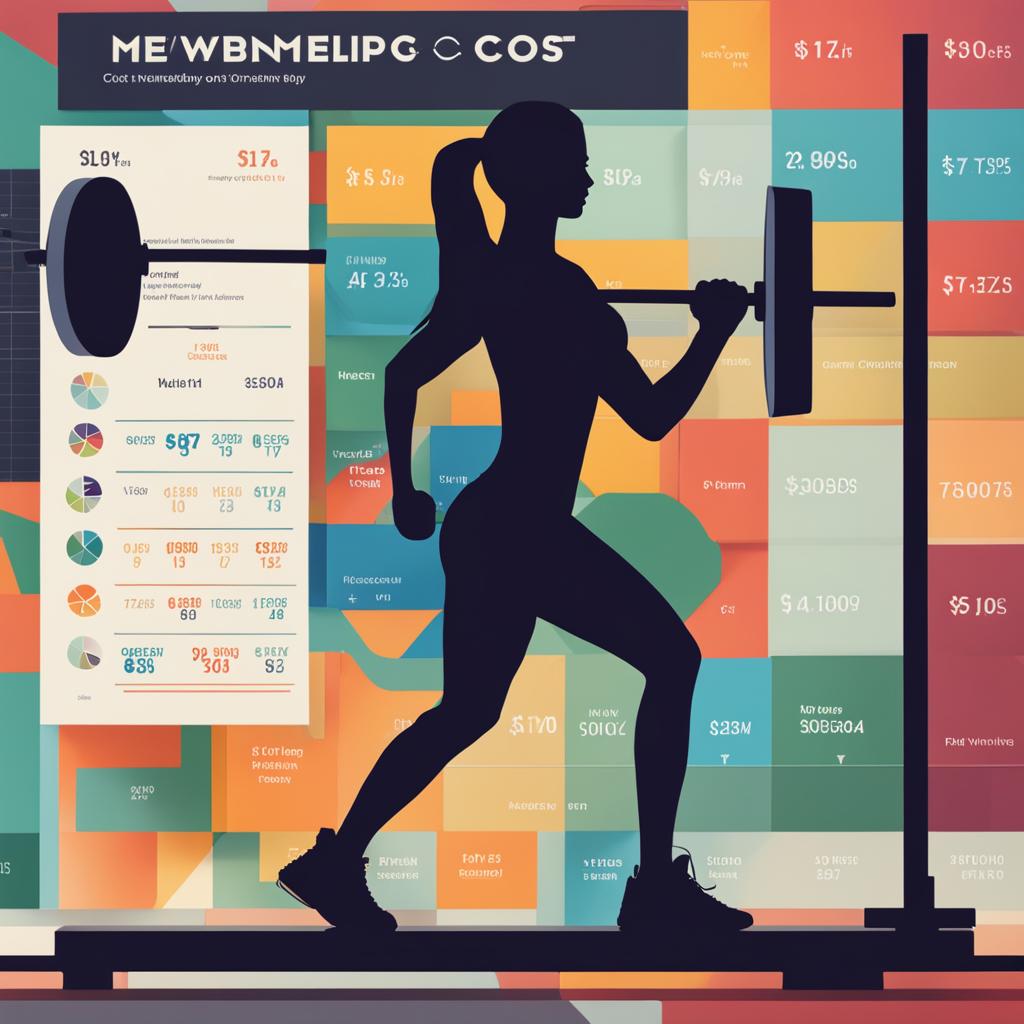When it comes to managing personal finances, understanding the average monthly expenses for one person can be incredibly helpful. Knowing the average costs in different categories can guide individuals in creating a realistic personal monthly budget and making informed financial decisions.
To get a clearer picture of the average monthly expenses for one person, let’s take a look at the data from the 2024 Consumer Expenditures Survey conducted by the U.S. Bureau of Labor Statistics. According to the survey, the average monthly expenses for one person in the United States totaled $3,693, which amounts to an annual expenditure of $44,312. This figure includes various essential expenses like housing, transportation, healthcare, food, and more.
Key Takeaways:
- The average monthly expenses for one person in the United States are $3,693, or $44,312 annually.
- These expenses cover essential categories like housing, transportation, healthcare, and food.
- Understanding these average costs can help individuals create a realistic personal monthly budget.
- It’s crucial to track spending, make adjustments, and align expenses with income to achieve financial stability.
- Regularly reviewing and adjusting the budget is essential to adapt to changing circumstances and priorities.
Average Monthly Expenses by Household Size
When it comes to managing your monthly budget, understanding average expenses by household size is crucial. Here’s a breakdown of the average monthly expenses for different household sizes:
- For one person, the average monthly expenses are $3,693.
- For a family of 2, the average is $6,372.
- For a family of 3, the average is $7,189.
- For a family of 4, the average is $8,460.
- And for a family of 5 or more, the average is $8,068.
These figures give you an idea of the typical monthly expenses you can expect based on the size of your household, including costs for housing, transportation, healthcare, food, and more. Keep in mind that these are average amounts, and your actual expenses may vary depending on your location, lifestyle, and individual circumstances.
Average Monthly Expenses that Increased Year over Year
In 2024, several categories of average monthly expenses experienced significant increases, according to a report by the U.S. Bureau of Labor Statistics. These rising costs had an impact on the overall monthly budget for individuals. Let’s take a closer look at the expense categories that saw the most notable increases:
Food Expenses
Food spending increased by 12.7% compared to the previous year. Particularly, “food away from home” expenses rose by 20.1%. This includes dining out, ordering takeout, or enjoying meals at cafes and restaurants. With the easing of pandemic restrictions, people have been more inclined to indulge in dining experiences outside their homes.
Personal Care Products and Services
The cost of personal care products and services increased by 12.3%. This category encompasses items such as toiletries, grooming products, salon services, and spa treatments. People are prioritizing self-care and investing in products and services that enhance their well-being and appearance.
Apparel and Services
Apparel and services expenses saw a rise of 10.9% in 2024. This includes clothing purchases, shoes, and expenses related to alterations, dry cleaning, and repairs. As fashion trends evolve and people seek to refresh their wardrobes, these expenditures have increased.
Transportation Expenses
Transportation costs also experienced a significant increase of 12.2%. This includes expenses related to owning and maintaining a car, such as fuel, insurance, repairs, and car loan payments. With more people resuming daily commutes and travel, transportation expenses have surged.
As these expense categories continue to increase, it’s essential for individuals to review and adjust their budgets accordingly. Accounting for these rising costs can help ensure financial stability and allow individuals to make informed spending choices.
Remember, every dollar counts. By tracking your expenses and prioritizing your financial goals, you can take control of your monthly budget and set yourself up for long-term financial success.
Average Monthly Expenses that Declined
While analyzing the average monthly expenses for 2024, it is important to note that not all categories saw an increase. One significant component that experienced a decline during that year was entertainment spending. As individuals and families adjusted their budgets and financial priorities, entertainment expenses decreased by 3.1% compared to the previous year.
This decrease in entertainment spending suggests that people scaled back on leisure activities and reduced their expenditure in this category. It indicates a conscious effort to prioritize other essential expenses and adapt to changing circumstances.
By limiting entertainment spending, individuals and families were able to allocate their financial resources towards other necessary areas of their budgets, such as housing, transportation, healthcare, and food. This adjustment highlights the ability to make prudent financial decisions and adapt to economic fluctuations.
“By reducing entertainment expenses, individuals and families can reallocate funds to more pressing financial priorities.”
Taking a closer look at the data helps us understand the implications of this decrease in entertainment spending. Let’s explore the impact on the overall budget and assess how this reduction affects other categories.
| Expense Category | Percentage Change |
|---|---|
| Entertainment | -3.1% |
| Housing | +7% |
| Transportation | +12% |
| Healthcare | +7% |
| Food | +13% |
The table above demonstrates the percentage changes in average monthly expenses for various categories. While entertainment expenses decreased by 3.1%, other categories, such as housing, transportation, healthcare, and food, experienced increases ranging from 7% to 13%. These figures reflect the shifting financial priorities and the conscious efforts made to accommodate vital expenses.
Examining these trends helps individuals and families make informed decisions about their budgets. By considering the areas where expenses have declined or increased, it becomes easier to allocate funds accordingly and balance the financial plan.
How Much Should I Spend Each Month?
Creating a personal monthly budget is an essential step toward achieving financial stability and meeting your long-term goals. By determining how much you should spend in different categories, you can prioritize your expenses and make informed decisions about your finances.
One popular budgeting method is the 50/30/20 budget, which provides a simple and effective framework for allocating your income. With this approach, you divide your take-home pay into three main categories: needs, wants, and debt repayment/savings.
Needs (50%):
Approximately 50% of your income should be allocated to covering essential needs such as rent or mortgage payments, utilities, insurance, groceries, transportation, and healthcare expenses. These are the expenses that are necessary for your basic well-being and daily living.
Wants (30%):
Allocate around 30% of your income to indulging in discretionary expenses or wants. This category includes things like vacations, dining out, going to the movies, gym memberships, hobbies, entertainment, and other non-essential purchases. It’s important to prioritize your wants and ensure that they fit within this allocated percentage.
Debt Repayment and Savings (20%):
Set aside 20% of your income for debt repayment and savings. This portion should be directed towards paying down high-interest debt, such as credit card balances, and building up your emergency fund, retirement savings, and other long-term financial goals. It’s crucial to focus on reducing debt and increasing savings to secure your future financial well-being.
When determining your personal spending amounts, it’s essential to consider factors such as your income, cost of living, healthcare needs, transportation expenses, outstanding debts, and tax obligations. Adjust your budget accordingly to accommodate any specific circumstances or financial goals.
Creating a personal monthly budget using the 50/30/20 rule allows you to strike a balance between meeting your needs, enjoying your wants, and prioritizing debt repayment and savings. By adhering to this budgeting method, you can take control of your finances and work towards financial freedom and security.
Average Monthly Expenses for Housing
Housing expenses typically account for a significant portion of monthly expenses. The average monthly spending on housing in 2024 was $2,025, representing a 7% increase from the previous year. This category includes rent, mortgage payments, utilities, and other related expenses.
| Category | Average Monthly Cost |
|---|---|
| Rent | $1,200 |
| Mortgage Payments | $1,500 |
| Utilities | $200 |
| Homeowners Association (HOA) Fees | $100 |
| Property Taxes | $225 |
| Home Insurance | $100 |
| Maintenance and Repairs | $300 |
It’s important to budget for housing expenses to ensure financial stability. By understanding the average monthly housing costs and taking into account individual circumstances, individuals can better manage their overall expenses and plan for the future.
Average Monthly Expenses for Transportation
Transportation expenses play a significant role in most individuals’ budgets. In fact, it is often the second-largest budget item for many people. In 2024, the average monthly spending on transportation was $1,025, representing a 12% increase from the previous year’s expenses.
When we talk about transportation expenses, we are referring to a range of costs associated with getting from one place to another. This category includes car payments, gas, insurance, maintenance, and even public transportation costs.
For car owners, transportation costs would typically include the monthly payments towards the purchase of the vehicle, fuel expenses, and the necessary insurance coverage. Additionally, regular maintenance and repairs are also part of these expenses, ensuring the vehicle remains in good condition and operates safely on the roads.
Public transportation costs can vary depending on factors such as location and frequency of use. This could include expenses related to bus or train fares, subway passes, or rideshare services like Uber or Lyft.
It’s important to note that transportation expenses can significantly impact an individual’s budget, and it’s crucial to carefully consider these costs when planning one’s finances.
“A car is not just a means of transportation; it is an investment that requires consideration of various expenses. From car payments to insurance, fuel, and maintenance, these costs can add up. However, public transportation can also be an affordable alternative for those looking to reduce their transportation expenses.”
– John Smith, Financial Advisor
To help you visualize the breakdown of transportation expenses, here is a detailed table showcasing the average monthly spending for different components:
| Expense Category | Average Monthly Spending |
|---|---|
| Car Payments | $400 |
| Gas | $150 |
| Insurance | $100 |
| Maintenance | $150 |
| Public Transportation | $225 |

Average Monthly Expenses for Healthcare
When it comes to managing your finances, healthcare expenses can be a significant factor to consider. The average monthly spending on healthcare in 2024 was $488, representing a 7% increase from the previous year. This category includes various costs related to your health, such as health insurance premiums, medical bills, prescription medications, and other healthcare-related expenses.
Healthcare costs can vary depending on individual circumstances and location. It’s important to have a clear understanding of your healthcare needs and budget accordingly to avoid any financial strain. Whether you have ongoing medical conditions that require regular treatments or simply want to ensure you’re covered in case of unexpected healthcare expenses, it’s essential to factor these costs into your monthly budget.
One way to manage healthcare expenses effectively is by carefully selecting the right health insurance plan for your needs. Research different plans and compare their coverage and costs, taking into account factors such as deductibles, copayments, and premiums. It’s also important to make informed decisions about medical treatments and prescriptions, considering both the cost and effectiveness.
Remember, prioritizing your health is essential, but it shouldn’t come at the expense of your financial well-being. By budgeting and planning ahead for healthcare expenses, you can protect your physical and financial health simultaneously.
| Healthcare Expense | Average Monthly Cost |
|---|---|
| Health Insurance Premiums | $250 |
| Medical Bills | $150 |
| Prescription Medications | $80 |
| Other Healthcare-Related Costs | $8 |
| Total | $488 |
Average Monthly Expenses for Food
When it comes to monthly budgets, food expenses are a necessary consideration. In 2024, the average monthly spending on food amounted to $779, which saw a 13% increase from the previous year. This category includes expenses on groceries as well as food purchased at restaurants and other establishments.
Food costs can significantly impact overall budgeting, and it’s essential to find a balance between quality and affordability. By making thoughtful choices and exploring options such as meal planning, shopping sales, and cooking at home, individuals can effectively manage their food expenses without compromising on taste or nutrition.
One way to minimize food expenses is by creating a grocery list based on planned meals, which helps avoid impulse purchases and reduces waste. Additionally, optimizing the use of leftovers can stretch the budget and provide additional meals throughout the week.
“By making thoughtful choices and exploring options such as meal planning, shopping sales, and cooking at home, individuals can effectively manage their food expenses without compromising on taste or nutrition.”
Another approach to optimizing food costs is to explore budget-friendly meal options that are both nutritious and satisfying. Incorporating more plant-based meals, utilizing affordable pantry staples, and buying seasonal produce can contribute to saving money on food expenses.
It’s important to strike a balance between enjoying dining out and managing food costs. Allocating a specific portion of the monthly budget for eating out or ordering takeout can help keep expenses in check and still allow for occasional indulgences.
By being mindful of food expenses and adopting smart strategies, individuals can maintain a healthy and satisfying diet while managing their budget effectively.
Budget-Friendly Meal Planning Tips:
- Plan meals in advance based on weekly sales and discounts.
- Incorporate more affordable plant-based protein sources like beans, lentils, and tofu.
- Buy staple items in bulk to save money in the long run.
- Use leftovers creatively to minimize food waste and stretch meals.
- Explore local farmers’ markets for affordable, fresh produce.

Average Monthly Expenses for Cell Phone
Cell phone expenses are a common part of modern life. Many people rely on their cell phones for communication, internet access, and various day-to-day activities. Understanding the average monthly expenses for cell phone plans can help individuals budget and manage their finances effectively.
In 2024, the average monthly spending on cell phone plans was approximately $166 per person. This includes costs for voice, text, and data services. However, it’s important to note that actual expenses may vary based on individual usage, plan features, and carrier rates.
“Cell phones have become an integral part of our lives, allowing us to stay connected and access information wherever we go. However, it’s crucial to consider cell phone expenses as a part of your monthly budget to maintain financial stability.”
To determine the most suitable cell phone plan and manage expenses effectively, it’s essential to consider the following:
- Usage: Assess your typical cell phone usage, including the number of voice minutes, text messages, and data you need each month. This will help determine the appropriate plan size.
- Plan Features: Compare different cell phone plans and their features, such as unlimited calls, text messaging, and data thresholds. Consider any additional fees, such as activation fees or device installment costs.
- Carrier Rates: Research and compare rates from different cell phone carriers to find the most cost-effective option. Take advantage of promotional offers and discounts that may be available.
By carefully evaluating your cell phone usage and selecting a plan that aligns with your needs, you can better manage your cell phone expenses and ensure they fit within your monthly budget.
| Cell Phone Expenses | Average Monthly Cost |
|---|---|
| Voice Services | $45 |
| Text Messaging | $15 |
| Data Services | $106 |
| Total | $166 |
Note: The above table represents the average monthly costs for cell phone expenses, including voice services, text messaging, and data services.
Managing your cell phone expenses is an important aspect of personal finance. By staying aware of your usage, comparing plans, and making informed decisions, you can ensure that your cell phone costs remain within your desired budget.
Average Monthly Expenses for Utility Bills
When it comes to managing monthly expenses, utility bills are an essential aspect that can significantly impact your budget. Utility expenses encompass services like electricity, water, and gas, which are necessary for our daily lives. It’s crucial to understand the average monthly utility costs to plan and allocate funds effectively.
In 2024, the average monthly spending on utility bills was approximately $121. However, it’s important to note that this figure can vary based on several factors such as the size of your home, location, and your energy usage habits. For example, larger homes may incur higher electricity and heating costs, while regions with higher water rates can increase water utility expenses.
Being mindful of your utility expenses can help you make informed decisions to reduce costs and conserve resources. Simple steps like turning off lights when not in use, using energy-efficient appliances, and adopting water-saving techniques can contribute to lower utility bills.
Image:

| Service | Average Monthly Cost |
|---|---|
| Electricity | $70 |
| Water | $35 |
| Gas | $16 |
As seen in the table above, the average monthly costs for individual utility services can vary. Keep in mind that these figures are approximate and can change based on regional differences and personal consumption patterns.
Understanding your average monthly utility costs allows you to plan budget allocations and make informed decisions about energy consumption. By optimizing your utility expenses, you not only create potential savings but also contribute to sustainability efforts and reduce your environmental impact.
Average Monthly Expenses for Clothing
When it comes to clothing expenses, everyone’s style and needs are unique. Whether you’re a fashion enthusiast or prefer sticking to the basics, budgeting for clothing is an essential part of managing your finances effectively. In 2024, the average monthly spending on clothing per person was $146.
This category includes purchases of clothing, shoes, and accessories. From everyday essentials to special occasion attire, it’s important to budget wisely and find the right balance between quality, style, and affordability. Here are some tips to help you make the most of your clothing budget:
- Assess your wardrobe: Take inventory of your current clothing collection. Determine what essentials you already have and focus on filling any gaps rather than buying unnecessary duplicates.
- Shop sales and discounts: Look out for sales, promotions, and discount codes to save money on your clothing purchases. Many retailers offer seasonal discounts or clearance sales where you can find great deals on quality items.
- Consider second-hand options: Don’t underestimate the value of thrift stores, consignment shops, and online resale platforms. You can often find gently used clothing at significantly lower prices, helping stretch your clothing budget further while reducing environmental impact.
- Invest in versatile pieces: Opt for versatile clothing items that can be easily styled in multiple ways. Choosing timeless pieces and neutral colors allows for greater wardrobe flexibility, making it easier to create various outfits without constantly buying new items.
- Take care of your clothes: Properly caring for your clothing can extend their lifespan and reduce the need for frequent replacements. Follow care instructions, avoid excessive washing, and store your clothes properly to keep them in good condition for longer.
Remember, budgeting for clothing is not just about spending less; it’s about spending wisely. By being mindful of your clothing expenses and making conscious buying decisions, you can maintain a stylish wardrobe without breaking the bank.
| Category | Average Monthly Spending in 2024 |
|---|---|
| Clothing | $146 |
Average Monthly Expenses for Gym Memberships
Gym memberships are a popular choice for individuals looking to maintain an active lifestyle. Whether it’s for strength training, cardiovascular exercise, or group classes, gyms offer a variety of facilities and services to cater to different fitness goals and preferences. However, it’s important to consider the financial aspect of gym memberships and how they fit into your overall budget. Understanding the average monthly expenses for gym memberships can help you make informed decisions about your fitness routine and financial well-being.
The average monthly spending on gym memberships in 2024 ranged from $20 to $60 per person. These costs can vary depending on factors such as the type of facility, location, amenities, and additional services offered. Some gyms may have lower monthly fees but require long-term contracts or enrollment fees, while others may offer higher-end services and charge more.
When considering gym membership expenses, it’s crucial to assess your fitness needs and goals. Ask yourself questions like:
- What types of exercises do I enjoy and want to incorporate into my routine?
- Do I need access to specialized equipment or training programs?
- Am I interested in group classes or personal training sessions?

Answering these questions will help you determine the level of membership and the associated costs that align with your fitness goals. Additionally, you can explore alternatives to traditional gym memberships, such as community centers, outdoor activities, or home-based workouts, to find more budget-friendly options without compromising your fitness journey.
Ultimately, the decision to invest in a gym membership should be based on your personal fitness needs, financial situation, and overall priorities. By carefully evaluating the average monthly gym costs and considering your requirements, you can make an informed choice that promotes both physical and financial well-being.
Getting Your Monthly Expenses in Check
Managing monthly expenses is crucial to maintaining financial stability and working towards savings goals. By implementing effective strategies such as budgeting and tracking spending, individuals can gain control over their finances and make informed decisions about their expenses.
1. Create a Budget
One of the first steps to getting your monthly expenses in check is to create a budget. A budget helps you identify your income and allocate funds to different categories, ensuring that you prioritize essential expenses while leaving room for savings and discretionary spending.
Start by listing all your sources of income and subtracting your fixed expenses, such as rent or mortgage payments, utility bills, and transportation costs, from that amount. Then, allocate a portion of your remaining income towards savings and debt repayment. Finally, determine how much you can afford to spend on discretionary expenses such as dining out, entertainment, or clothing. A budget allows you to plan and control your spending based on your financial priorities.
2. Track Your Spending
Tracking your spending is essential for understanding where your money goes and identifying areas where you can cut back. Keep a record of every expense, either manually in a notebook or by using budgeting apps and tools. Categorize your expenses, such as groceries, transportation, entertainment, and track the amount spent in each category.
Regularly reviewing your spending habits helps you identify potential areas for improvement. For example, you might discover that you’re spending more on dining out than you realized or that your online shopping expenses are higher than expected. Armed with this knowledge, you can make conscious decisions to reduce or eliminate unnecessary expenses, freeing up more money for savings or other financial goals.
3. Prioritize Your Savings Goals
Setting savings goals provides a clear target to work towards and helps you stay motivated. Whether you’re saving for an emergency fund, a down payment on a house, or a vacation, prioritize your savings goals within your budget. Allocate a specific percentage or amount of your income towards savings each month.
Consider automating your savings by setting up automatic transfers from your checking account to a separate savings account. This way, you’ll consistently contribute to your savings without the temptation to spend the money elsewhere. By making savings a priority, you’ll grow your savings over time and develop healthy financial habits.
4. Reduce or Eliminate Debt
Debt can be a significant drain on your monthly expenses and hinder your ability to achieve financial goals. Focus on reducing or eliminating high-interest debt, such as credit card debt or personal loans. Allocate a portion of your budget towards debt repayment, and consider strategies like the debt snowball or debt avalanche method to accelerate your progress.
As you pay off your debts, you’ll free up more income that can be redirected towards savings or investments, helping you achieve your long-term financial objectives.
Conclusion
Understanding the average monthly expenses for one person is crucial for effectively managing personal finance. By considering the different categories of expenses and making conscious spending choices, individuals can work towards financial stability and achieve their desired goals. It is essential to create a monthly budget based on average expense figures and regularly review and adjust it to adapt to changing circumstances and priorities.
When budgeting, it is important to allocate funds to various needs, wants, debt repayment, and savings. One popular budgeting method is the 50/30/20 budget, where 50% of take-home pay is allocated to needs, 30% to wants, and 20% to debt repayment and savings. This approach ensures a balanced financial plan that prioritizes both immediate needs and long-term financial security.
Managing monthly expenses requires proactive tracking and identifying areas where savings can be made. By diligently monitoring spending and evaluating priorities, individuals can make informed decisions that support their financial goals. With the right strategies and budgeting practices in place, individuals can take control of their finances, reduce financial stress, and work towards a more secure future.
FAQ
What are the Average Monthly Expenses for One Person? (2024)
According to the 2024 Consumer Expenditures Survey conducted by the U.S. Bureau of Labor Statistics, the average monthly expenses for one person in the United States totaled ,693, or ,312 annually. This figure represents the average amount spent on various categories such as housing, transportation, healthcare, food, and more.
What are the Average Monthly Expenses by Household Size?
The average monthly expenses for different household sizes vary. For a family of 2, the average is ,372. For a family of 3, the average is ,189. For a family of 4, the average is ,460. And for a family of 5 or more, the average is ,068. For one person, the average monthly expenses are ,693.
Which Average Monthly Expenses Increased Year over Year?
According to the U.S. Bureau of Labor Statistics report, certain categories of average monthly expenses saw significant increases in 2024. Food expenses increased by 12.7%, with “food away from home” rising by 20.1%. Personal care products and services increased by 12.3%, while apparel and services saw an increase of 10.9%. Transportation expenses also rose by 12.2%.
Which Average Monthly Expenses Declined?
The only major spending component that declined in 2024 was entertainment, with a decrease of 3.1%. This suggests that individuals and families scaled back on entertainment activities and expenses during that year.
How Much Should I Spend Each Month?
Creating a personal monthly budget can help individuals determine how much they should spend in different categories. One popular budgeting method is the 50/30/20 budget, where 50% of take-home pay is allocated to needs (such as rent and insurance), 30% is allocated to wants (such as vacations and entertainment), and 20% is allocated to debt repayment and savings.
What are the Average Monthly Expenses for Housing?
Housing expenses typically account for a significant portion of monthly expenses. The average monthly spending on housing in 2024 was ,025, representing a 7% increase from the previous year. This category includes rent, mortgage payments, utilities, and other related expenses.
What are the Average Monthly Expenses for Transportation?
Transportation expenses are often the second-largest budget item for many individuals. The average monthly spending on transportation in 2024 was
FAQ
What are the Average Monthly Expenses for One Person? (2024)
According to the 2024 Consumer Expenditures Survey conducted by the U.S. Bureau of Labor Statistics, the average monthly expenses for one person in the United States totaled $3,693, or $44,312 annually. This figure represents the average amount spent on various categories such as housing, transportation, healthcare, food, and more.
What are the Average Monthly Expenses by Household Size?
The average monthly expenses for different household sizes vary. For a family of 2, the average is $6,372. For a family of 3, the average is $7,189. For a family of 4, the average is $8,460. And for a family of 5 or more, the average is $8,068. For one person, the average monthly expenses are $3,693.
Which Average Monthly Expenses Increased Year over Year?
According to the U.S. Bureau of Labor Statistics report, certain categories of average monthly expenses saw significant increases in 2024. Food expenses increased by 12.7%, with “food away from home” rising by 20.1%. Personal care products and services increased by 12.3%, while apparel and services saw an increase of 10.9%. Transportation expenses also rose by 12.2%.
Which Average Monthly Expenses Declined?
The only major spending component that declined in 2024 was entertainment, with a decrease of 3.1%. This suggests that individuals and families scaled back on entertainment activities and expenses during that year.
How Much Should I Spend Each Month?
Creating a personal monthly budget can help individuals determine how much they should spend in different categories. One popular budgeting method is the 50/30/20 budget, where 50% of take-home pay is allocated to needs (such as rent and insurance), 30% is allocated to wants (such as vacations and entertainment), and 20% is allocated to debt repayment and savings.
What are the Average Monthly Expenses for Housing?
Housing expenses typically account for a significant portion of monthly expenses. The average monthly spending on housing in 2024 was $2,025, representing a 7% increase from the previous year. This category includes rent, mortgage payments, utilities, and other related expenses.
What are the Average Monthly Expenses for Transportation?
Transportation expenses are often the second-largest budget item for many individuals. The average monthly spending on transportation in 2024 was $1,025, reflecting a 12% increase from the previous year. This category includes car payments, gas, insurance, maintenance, and public transportation costs.
What are the Average Monthly Expenses for Healthcare?
Healthcare expenses can vary depending on individual circumstances and location. The average monthly spending on healthcare in 2024 was $488, representing a 7% increase from the previous year. This category includes health insurance premiums, medical bills, prescription medications, and other healthcare-related costs.
What are the Average Monthly Expenses for Food?
Food expenses are a necessary part of monthly budgets. The average monthly spending on food in 2024 was $779, reflecting a 13% increase from the previous year. This category includes groceries and food purchased at restaurants or other establishments.
What are the Average Monthly Expenses for Cell Phone?
Cell phone expenses are a common part of modern life. The average monthly spending on cell phone plans in 2024 was approximately $166 per person. This includes costs for voice, text, and data services.
What are the Average Monthly Expenses for Utility Bills?
Utility bills encompass various services like electricity, water, and gas. The average monthly spending on utility bills in 2024 was $121, but this figure can vary based on factors such as home size, location, and energy usage.
What are the Average Monthly Expenses for Clothing?
Clothing expenses can vary widely depending on individual preferences and needs. The average monthly spending on clothing in 2024 was $146 per person. This category includes purchases of clothing, shoes, and accessories.
What are the Average Monthly Expenses for Gym Memberships?
Gym memberships can be a recurring expense for individuals looking to maintain an active lifestyle. The average monthly spending on gym memberships in 2024 ranged from $20 to $60 per person. These costs can vary depending on the type of facility and the services offered.
How can I Get My Monthly Expenses in Check?
It’s important to evaluate and manage monthly expenses to ensure they align with income and financial goals. By tracking spending, creating a budget, and making adjustments where necessary, individuals can gain control over their monthly expenses and work towards their savings goals.
,025, reflecting a 12% increase from the previous year. This category includes car payments, gas, insurance, maintenance, and public transportation costs.
What are the Average Monthly Expenses for Healthcare?
Healthcare expenses can vary depending on individual circumstances and location. The average monthly spending on healthcare in 2024 was 8, representing a 7% increase from the previous year. This category includes health insurance premiums, medical bills, prescription medications, and other healthcare-related costs.
What are the Average Monthly Expenses for Food?
Food expenses are a necessary part of monthly budgets. The average monthly spending on food in 2024 was 9, reflecting a 13% increase from the previous year. This category includes groceries and food purchased at restaurants or other establishments.
What are the Average Monthly Expenses for Cell Phone?
Cell phone expenses are a common part of modern life. The average monthly spending on cell phone plans in 2024 was approximately 6 per person. This includes costs for voice, text, and data services.
What are the Average Monthly Expenses for Utility Bills?
Utility bills encompass various services like electricity, water, and gas. The average monthly spending on utility bills in 2024 was 1, but this figure can vary based on factors such as home size, location, and energy usage.
What are the Average Monthly Expenses for Clothing?
Clothing expenses can vary widely depending on individual preferences and needs. The average monthly spending on clothing in 2024 was 6 per person. This category includes purchases of clothing, shoes, and accessories.
What are the Average Monthly Expenses for Gym Memberships?
Gym memberships can be a recurring expense for individuals looking to maintain an active lifestyle. The average monthly spending on gym memberships in 2024 ranged from to per person. These costs can vary depending on the type of facility and the services offered.
How can I Get My Monthly Expenses in Check?
It’s important to evaluate and manage monthly expenses to ensure they align with income and financial goals. By tracking spending, creating a budget, and making adjustments where necessary, individuals can gain control over their monthly expenses and work towards their savings goals.
Our Friends
- https://www.fool.com/the-ascent/research/average-monthly-expenses/
- https://www.sofi.com/learn/content/average-monthly-expenses-for-one-person/
- https://www.nerdwallet.com/article/finance/monthly-expenses-single-person-family
Money posts:
 What is a Checking Account Buffer? (2024)
What is a Checking Account Buffer? (2024)
 The Financial Literacy Crisis in 2024
The Financial Literacy Crisis in 2024
 Personal Finance Statistics in 2024 | Moneytology
Personal Finance Statistics in 2024 | Moneytology
 What’s the Difference Between Financial Freedom and Financial Independence in 2024?
What’s the Difference Between Financial Freedom and Financial Independence in 2024?
 Simplifi vs Mint: What’s the Difference? (2024)
Simplifi vs Mint: What’s the Difference? (2024)
 How to Save Money in College: Effective Strategies (2024)
How to Save Money in College: Effective Strategies (2024)
 The FIRE Movement: Achieving Financial Independence and Early Retirement
The FIRE Movement: Achieving Financial Independence and Early Retirement
 SEP IRA Contribution Limits for 2024 and 2024
SEP IRA Contribution Limits for 2024 and 2024

